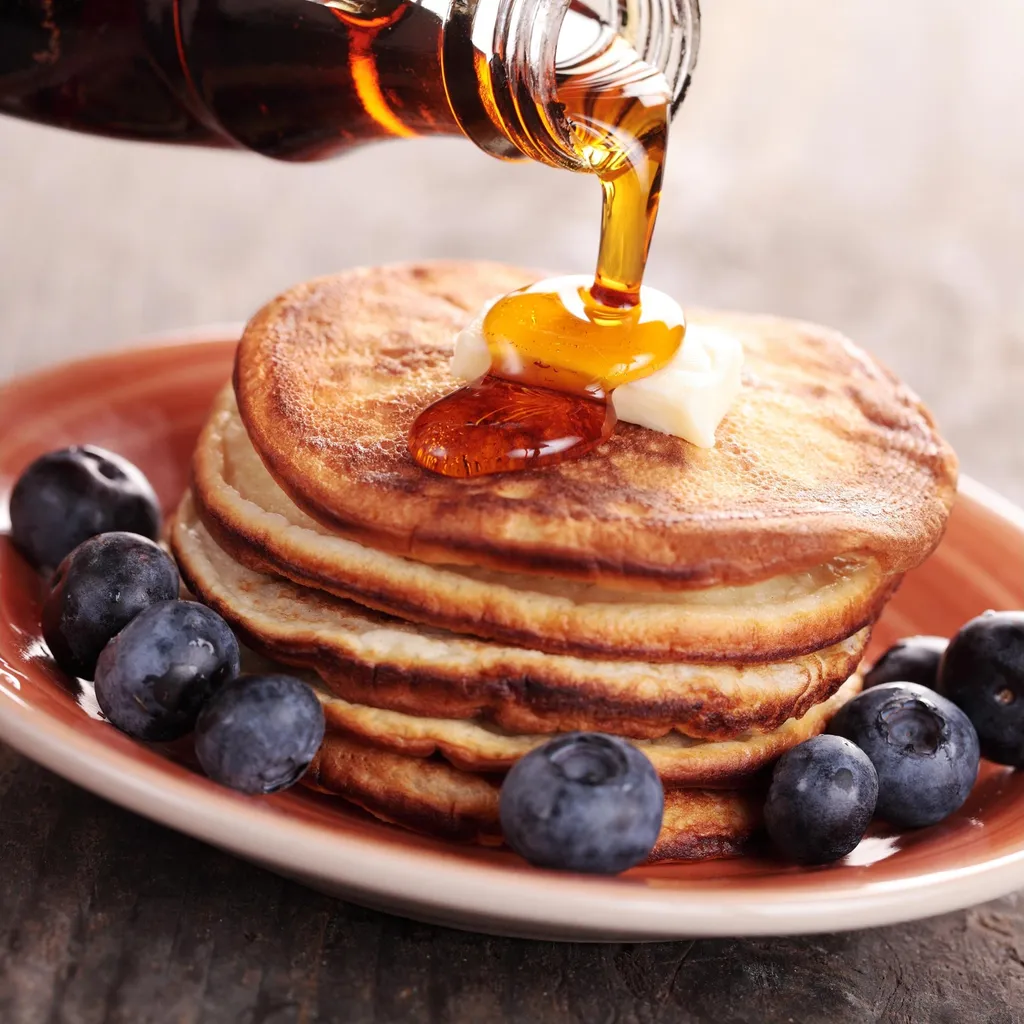

Are you a grade B maple syrup fan? For a lot of maple syrup connoisseurs, grade B was always the go-to syrup. It’s dark, caramelly, rich, and complex. But unfortunately, you can’t get it anymore. To understand why, we have to look at the science behind the whole process, from sap to syrup. On the way, we’ll cover hydrometers, reverse osmosis, boiling point elevation, and George’s dislike of Maillard reaction diagrams:
Video Transcript:
I learned a long time ago that I’m a Grade B maple syrup guy. It’s caramelly, it’s dark, it’s rich, it’s complex.
Other than that though, I didn’t know much. I had no idea what the different grades meant or how you make them in the first place.
And tragically, you can’t even get Grade B anymore.
So I went to Vermont to find out why.
(upbeat music)
(drill buzzing) (bell dings)
Okay, let me do it one more time.
(woman laughs)
[Host] Meet Bill and Susan, owners of Glastenview Maple Farm.
Hello, I’m Bill Freeman. This is my wife, Susan. We’re the owners of Glastenview Maple Farm.
Small batch producers. They make about 150 gallons of syrup a year.
Now, I’d love for them to cook me up some Grade B, but it turns out maple syrup producers have fairly little, if any, control over what grade of syrup they produce.
To understand why and to see why you can’t even get Grade B anymore, we have to look at the science behind the whole process from sap to syrup.
Right here.
Yep.
And does this angle look good?
[Bill] A little less.
Little less like that.
Great.
First, what I’m poorly demonstrating here is one older technique for gathering maple sap. Drill into a maple tree, stick a tap in there, hang a bucket, and come back a few hours later, boom, sap.
Now, if you are trying to make a lot of syrup, this is not the most efficient technique.
This is much more efficient. sap from 50 to 150 trees flows down these blue tubes into this black mainline tube, and then collects here in this gigantic bucket.
You can even hook up a vacuum pump to speed up the collection process and pull more sap out of the tree.
Biology break. All plants use photosynthesis to produce glucose, which they then convert to sucrose, table sugar.
They’re not producing it for us. They metabolize it for energy. They turn some of it into cellulose to grow, and they turn some of it into starch to save for later.
Now, photosynthesis generates sugar in the leaves, but plants need to transport it everywhere. And they do that by dissolving it in water, thus generating sap and moving that sap through vessels called phloem and xylem.
(bell chiming)
But wait a second. If all plants are doing this, why do we mostly make syrup from maple trees?
Because maples are one of the few species of tree that exudes sap if you poke a hole into the trunk.
Okay, but why do they do that?
It’s complicated. The short version is maples have air bubbles in the cells lining their xylem vessels. Most plants don’t.
So when the temperature drops below freezing, those bubbles shrink and create negative pressure. When temperatures warm back up, the bubbles grow and you you get positive pressure.
In the spring, when warm days follow below freezing nights, pressures in the xylem at the base of a tall maple tree can exceed 40 pounds per square inch.
Drill a hole, stick a tap in there, and sap comes dripping out.
Bill and I, mostly Bill and Sue, collected about 100 gallons of sap to turn into syrup.
Now, the traditional way to maple syrup is to just take the sap and boil it.
Sap can be anywhere from one to 5% sugar. Usually, it’s about 2%.
Maple syrup, by law, has to be at least 66% sugar, 66.9 in Vermont and New Hampshire.
Now, what’s so special about 66% or 66.9%? Below 66, the syrup spoils more easily. And above 67%, the sugar starts to crystallize out. 66 to 67% is the Goldilocks Zone.
When you buy maple syrup, you’re expecting a product that won’t spoil and won’t crystallize. And the FDA is here to make sure you get it.
The FDA’s food labeling laws are how you know you’re actually buying what you think you’re buying.
Without them, anyone could produce a syrup that’s only 50% sugar or 55% sugar for a lot less money, by the way, label it maple syrup, and legally sell it right next to a maple syrup that’s 66% sugar.
And the way you get your sugar content high enough is with the evaporator. This is where 2% sugar or sap becomes 66% sugar syrup.
To get from 2% to 66%, you have to boil away a lot of water.
Now the sap Bill and I collected was 1.8% sugar, which means that to make one gallon of maple syrup, we’ll need 48 gallons of sap.
That’s a pretty wild ratio and explains why you need hundreds of maple trees and an efficient way to process all that sap to be a profitable maple syrup operation.
Modern evaporators like Bill and Sue’s have multiple pans. All of which are heated by this massive wood stove. Fresh sap flows in here, and pushes the sap that was already in the evaporator forward along this circuitous path.
And the sap becomes more and more concentrated as it flows since it’s in contact with the heat for longer and longer. And like with many foods, heat is why the magic happens.
Now, this is a really important point. Maple syrup, it is not just maple tree sap with a bunch of water removed, okay?
Boiling the sap does way more than just concentrate the sugars.
It drives all kinds of chemical reactions that turn maple syrup brown and give it its characteristic flavor. Specifically caramelization reactions and Maillard reactions.
Now, calling these reactions is technically accurate, but each one is really more like a book of reactions or an entire library of reactions or a large seafaring vessel stuffed to the brim with chemical reactions.
I mean, just look at this general scheme of the Maillard reaction. Look at it. It’s shaded, gray bubbles all over the place, shaded bubbles. What is this? Business school?
Let me just tell you something. When chemists start using diagrams that look like a third grader made them in power…
(buzzer buzzes)
Caramelization happens in all kinds of foods. But the classic example is when you heat sugar to the point that it becomes caramel, caramel, caramel, caramel.
The Maillard reactions happen whenever you heat sugars in the presence of amino acids or proteins.
Both sets of reactions need heat, which again, is why you can’t make maple syrup without at some point boiling the sap.
Anyway, both caramelization and Maillard reactions produce dark colors and complex rich flavors.
And I would love to give you a list of chemical structures and say, “These molecules are responsible for maple syrup’s flavor.”
But I really can’t do that.
Despite the fact that maple syrup has been made on this continent for centuries, we still don’t fully understand exactly what chemicals are responsible for maple syrup’s distinctive color and flavor.
The bottom line is, anytime you heat a complex natural product like tree sap, which in addition to sucrose contains these molecules, you’re driving high hundreds, maybe thousands of chemical reactions and generating all kinds of products.
So the best I can do is say that these general types of molecules are probably responsible for at least some of maple syrup’s flavor.
In the meantime, Canada (“O Canada”) has made a 91 component flavor wheel to help us discuss maple syrup flavors. 91!
Okay, how do you know when the sap’s done?
These days, most producers use a combination of a thermometer and a hydrometer to confirm that what they’re making is legally maple syrup.
When you boil water that’s got stuff dissolved in it, the boiling point of the solution goes up.
Why?
When you boil pure water, you’re putting in energy to break the hydrogen bonds that hold water together. When you boil a solution, you are also breaking bonds between the water molecules and whatever’s dissolved in them.
The higher the concentration of stuff, the more the boiling point goes up.
So a 66% sugar solution will boil at roughly 3.9 degrees Celsius or 7.1 degrees Fahrenheit higher than the boiling point of pure water.
But the tricky thing is the boiling point of pure water isn’t always 100 degrees Celsius.
It depends on the atmospheric pressure, which, in turn, depends on your altitude above sea level and the weather that day!
So getting to maple syrup is a little bit of trial and error.
Now, Bill has an auto draw-off, a temperature-activated automatic valve that opens at whatever temperature he sets it to.
So he starts at 219.1 degrees Fahrenheit. And when the temperature in this pan reaches 219.1, the liquid comes out.
But this stuff might not be legal maple syrup.
So what Bill does next is use something called a hydrometer to measure the density of the liquid.
Now, a hydrometer is basically a sealed glass tube with a weight at the bottom of it. The denser a liquid is, the heavier it is per unit volume, the more it pushes up on the air-filled hydrometer, the higher it floats in the liquid.
Nope, density is too low. So Bill bumps the temperature setting up a bit.
Remember, the higher the concentration of sugar in water, the higher it’s boiling point. So, by bumping the temperature point upward, Bill is basically saying to this valve, “You keep your trap shut until you hit a higher temperature,” and thus a higher sugar content.
Eventually, he hits a temperature that produces 66.9% maple syrup. And then we just collect.
And by that, I mean, he collects while I watch uselessly and taste from little plastic shot glasses.
Now, these shot glasses are completely optional, but let me tell you, that hot unfiltered maple syrup straight from the evaporator is one of the best things I’ve ever tasted.
Next, you filter the syrup and bottle it. Here’s the three second musical montage of this process because this video is already entirely too long.
(upbeat music)
Boiling off 47 gallons of water to make one gallon of syrup, takes a long time and a lot of wood. And you have to do it pretty quickly after you collect all of the tree sap, which means that some seasons, you can be boiling till 3:00 am for days on end.
And last year, my wife and I were in here for seven and straight days boiling.
[Host] That led Bill and Sue to do something they’d been considering, but hesitant to do, buy a reverse osmosis or RO machine.
And it just cuts way down on the boiling time.
RO machines were originally invented to desalinate seawater, and they’re used in chemistry labs around the world to make ultrapure water.
RO systems are basically ultra high-pressure filtration systems.
This line in the middle is a membrane with lots of super, super small holes, barely bigger than a water molecule. Here on the left, you’ve got your tree sap, water with all those dissolved molecules. On the right, pure water.
Then you apply massive amounts of pressure to the left side here, forcing water through the holes in the membrane. All the other molecules are too big to fit, so they stay on the left, which means what you end up with is much more concentrated sap.
Now, in theory, you could concentrate the sap to 66% sugar but that would not produce maple syrup, because the RO barely heats the sap at all.
Bill and Sue use their RO to concentrate sap to about 8% sugar. Then they boil it the rest of the way.
Now, starting with 8% sugar means they only need about 11 gallons of sap to make a gallon of maple syrup instead of 48. And that cuts down dramatically on the amount of wood they need to burn and the time the boil takes.
But some traditional maple syrup producers were concerned that using an RO machine might affect the flavor of the syrup. So, researchers at the University of Vermont did a study in which they asked 46 lucky tasters to taste syrup produced using RO machines against syrup produced without RO machines.
Of course, the tasters did not know which one was which. The tasters liked both syrups equally and rated the RO produced syrups as having characteristic maple syrup flavor.
Essentially, using an RO system didn’t make any discernible difference to the flavor.
More studies since then have been done to confirm that result.
But since this is a relatively small batch we’re making here today, we are gonna do it the old-fashioned way.
This is now officially maple syrup. And you can’t see the color too well here, but when Bill eventually grades this, he’ll find that it’s Grade A amber color with a rich taste.
So where’s my Grade B?
While the FDA regulates what can legally be sold as maple syrup, it’s the USDA that provides guidance on grading.
Now, grading syrup is actually optional in most states, but in Vermont and a couple other states, you are required to, because Vermont takes their maple syrup seriously.
Grading is partly about darkness of the syrup, or to be more precise, percent transmittance of 560 nanometer wavelength light through a 10 millimeter sample of syrup. Which means, if you shoot a beam of this color light through 10 millimeters of maple syrup, and 75% or more of it makes it through the syrup, then you’ve got yourself the lightest possible grade of syrup.
Which before 2015, was legally allowed to be called Vermont Fancy, Ohio Grade A Light Amber, or Grade A Light Amber.
If a syrup transmits between 27 and 43.9% of this light, then you’ve got yourself a syrup, which before 2015 was legally allowed to be called Grade B in Vermont, Grade B finally, Extra Dark for Cooking in New York or Grade B for Reprocessing in most other states.
Now, imagine you’re a tourist in Vermont and you see two bottles of maple syrup on the shelf. One says, “Vermont Fancy.” And the other says, “Grade B,” which are you gonna assume is better?
Vermont Fancy, obviously.
But here’s the thing. A lighter color does not mean the syrup is better. Light and dark syrups have different taste profiles. Light syrup has a delicate maple flavor. Darker syrups have more caramel, caramel, toffee and coffee notes, in addition to the characteristic maple flavor.
In 2014, the International Maple Syrup Institute petitioned the USDA to rename the grading standards, partly because of the Grade A, Grade B issue, which they did in 2015.
So these days, there are four types of Grade A syrup, Golden-Delicate, Amber-Rich, Dark-Robust and Very Dark-Strong.
The words before the dash refer to the color, and the words after it refer to the flavor.
There’s no Grade B anymore. What used to be called Grade B is now called Grade A Dark-Robust or Grade A Very Dark-Strong.
Thank you very much.
Okay.
Thank you.
Thanks, guys.
Thank you.
Bye.
See you later.
Later.
This whole grading thing is fascinating. I mean, we’ve got this unimaginably complex chemical process that isn’t even fully understood.
And for the sake of marketing, we have to boil it down to a few words on a label, Grade B, Grade A, Dark-Robust, whatever.
So basically, this video was total clickbait. You can absolutely still get Grade B maple syrup but just has a better name now.

